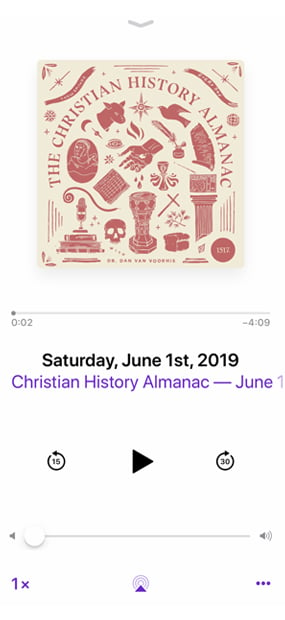Monday, February 3, 2025
Today on the Christian History Almanac, we head to the mailbag to answer a question about the history of the 10 Commandments.
*** This is a rough transcript of today’s show ***
It is the 3rd of February 2025. Welcome to the Christian History Almanac, brought to you by 1517 at 1517.org; I’m Dan van Voorhis.
A very happy Monday to you- as always, we head to the mailbag- but an announcement- this weekend will be a “questions you might be afraid to ask” or “things you’ve wondered but not asked” type of questions- I’ve been getting a lot of these recently and so send me your questions- seemingly obvious? You’ve always wondered but thought it was, maybe, a basic question… send them to me at danv@1517.org
Part of this was occasioned by an email I received from Kevin in West Suffield, Connecticut- which is part of Suffield, just north of Hartford (sorry about the Whalers) and home to Sylvester Graham, whom I think has had two shout-outs in the past two weeks. The graham cracker is really underrated.
How did Kevin’s question jump the queue? He’s a relatively new listener who received an Aeropress and a Book of Concord, and he now has a subscription to coffeebygillespie, so… enjoy! But Kevin was struck by a question that is in the top 10 of the most asked questions—he wondered why the Lutheran Ten Commandments are different from the numbering he is familiar with.
So- the 10 Commandments- or “10 Words” in Hebrew aren’t actually 10 distinct things. The traditional Jewish reading starts with “I am the Lord Your God, who brought you out of the land of Egypt,” and number 2 is “You shall have no other Gods before me.”
It was the sometimes erstwhile church father Origen who gave one popular numbering- “I am the Lord Your God” and “You shall have no other Gods” are Commandment 1 and number 2 is “You shall make no graven images”. The last Commandment is an injunction against coveting of all kinds.
It was Augustine who rolled those together- no other Gods and graven images as a subset under that- then the two kinds of coveting (goods and spouse) are separated (and I, for one, am good with that distinction).
So, in the Middle Ages, it was known that there were differing views, but the Western Catholic Church followed Augustine, and the Eastern Church followed Origen (which is interesting because, in the East, there is not nearly the concern about “graven images”).
Coming up to the Reformation, there were those who leaned towards iconoclasm (the removal and/or destruction of religious images) and noted that the “Catholic” way following Augustine didn’t make the “images” commandment distinct and called to follow Origen’s older numbering system. So- the “reformed” or ‘non-Lutheran-Reformation-folk’ adopted the new, old numbering with Origen and the Orthodox, while Catholics and Lutherans kept the old, new numbering of Augustine.
The issue of images did get its day in an early church council- the Second Council of Nicea in 787 ruled that religious images could be used for devotion and worship. When I brought this up on the largely Reformed White Horse Inn radio program, I was reminded that many in the Reformed camp do not recognize that ruling from the Second Council of Nicea and hold up the Origen-numbered Commandments as forbidding images for devotion and worship, which is their prerogative (councils can err!).
What gets interesting is when we ask different denominations how to number the commandments and untangle the civil, moral, and ceremonial, especially when it comes to the Sabbath—or changing that to the Lord’s Day. You can imagine that’s been tricky with Sabbatarians, but that’s for another time… Kevin, thanks for listening and sending in a question. Be like Kevin and send me some questions for the upcoming “things you were afraid to ask” mega mailbag.
The last word for today from the daily lectionary on God’s wisdom from 1st Corinthians 2:
6 We do, however, speak a message of wisdom among the mature, but not the wisdom of this age or of the rulers of this age, who are coming to nothing. 7 No, we declare God’s wisdom, a mystery that has been hidden and that God destined for our glory before time began. 8 None of the rulers of this age understood it, for if they had, they would not have crucified the Lord of glory. 9 However, as it is written:
“What no eye has seen,
what no ear has heard,
and what no human mind has conceived”—
the things God has prepared for those who love him—
10 these are the things God has revealed to us by his Spirit.
The Spirit searches all things, even the deep things of God.
This has been the Christian History Almanac for the 3rd of February 2025, brought to you by 1517 at 1517.org.
The show is produced by he is the man who can get you free roasted coffee, too at gillespie.coffee- he is Christopher Gillespie.
The show is written and read by a man who was surprised Uso took the Rumble… wow, I’m Dan van Voorhis.
You can catch us here every day- and remember that the rumors of grace, forgiveness, and the redemption of all things are true…. Everything is going to be ok.

Subscribe to the Christian History Almanac
Subscribe (it’s free!) in your favorite podcast app.